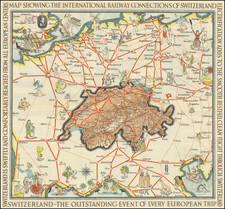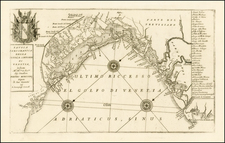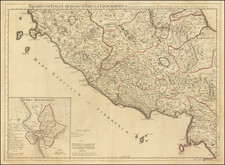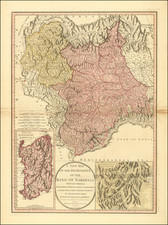Mapping The Pilgrimage of Saint Ursula
Rare map centered on the Alpine regions of Switzerland and Italy, published in Cologne by Abraham Hogenberg, son of Frans Hogenberg and heir to the Hogenberg publishing firm.
The map illustrates are rare work by Jesuit Hermanus Crombach (Cologne 1598-1680), published a large "biography" of Saint Ursula. The map shows a portion of the Journey of Saint Ursula and her companions, tracing the legendary voyage of Saint Ursula, a British princess who, according to medieval legend, embarked on a pilgrimage across Europe with 11,000 virgins before meeting martyrdom in Cologne at the hands of the Huns.
The map details the geographic features that dominate the landscape between Basel and Rome.
The legend of Saint Ursula and the 11,000 virgins is a tale interwoven with faith, mysticism, and martyrdom, originating from early Christian traditions. The story begins with an inscription circa 400 A.D. in the Church of St. Ursula in Cologne, which speaks of a restoration of a basilica at the site of the massacre of holy virgins. The name Ursula surfaces in texts from the 10th century, identifying her as one of these martyrs. According to the legend, Ursula was a princess in south-west Britain. At her father King Dionotus's behest, she embarked on a voyage with 11,000 virgin handmaidens to meet her betrothed, Conan Meriadoc of Armorica. After a storm miraculously transported them to the continent in a single day, Ursula decided to go on a pilgrimage across Europe before her wedding.
The pilgrimage led Ursula and her virginal company to Rome, where she convinced an anachronistic Pope Cyriacus and Sulpicius, the bishop of Ravenna, to join their pious expedition. However, upon reaching Cologne, they encountered the Huns laying siege to the city. In a tragic turn, the Huns massacred all the virgins, and Ursula herself was killed by an arrow around 383 A.D.
The story of Ursula is filled with supernatural occurrences and fabulous expansions over the centuries, many of which were viewed with skepticism even by medieval chroniclers. Early Christian writers like Jerome and Gregory of Tours do not mention her, and she is absent from the accounts of major hagiographers who compiled the lives of saints in the early Middle Ages.
The legend as we know it began to take shape in the 10th century when the leader of the martyred virgins was first referred to as Pinnosa or Vinnosa. The emphasis shifted to Ursula after the transfer of Pinnosa's relics to Essen around 947 and subsequent writings, such as the Passio Ursulae of 970, which named Ursula as the leader. This focus on Ursula was likely reinforced by the discovery of an epitaph referring to her as an "innocent virgin."
The enduring tale of Saint Ursula, albeit a blend of history and myth, remains a poignant narrative of piety and sacrifice, inspiring the veneration of Ursula and her companions through the centuries.










![Larii Lacus Vulgo Comensis Descriptio . . . [and] Terretorii Romani Descrip. [and] Fori Iulii Vulgo Frivli Typus](https://storage.googleapis.com/raremaps/img/small/67593.jpg)



